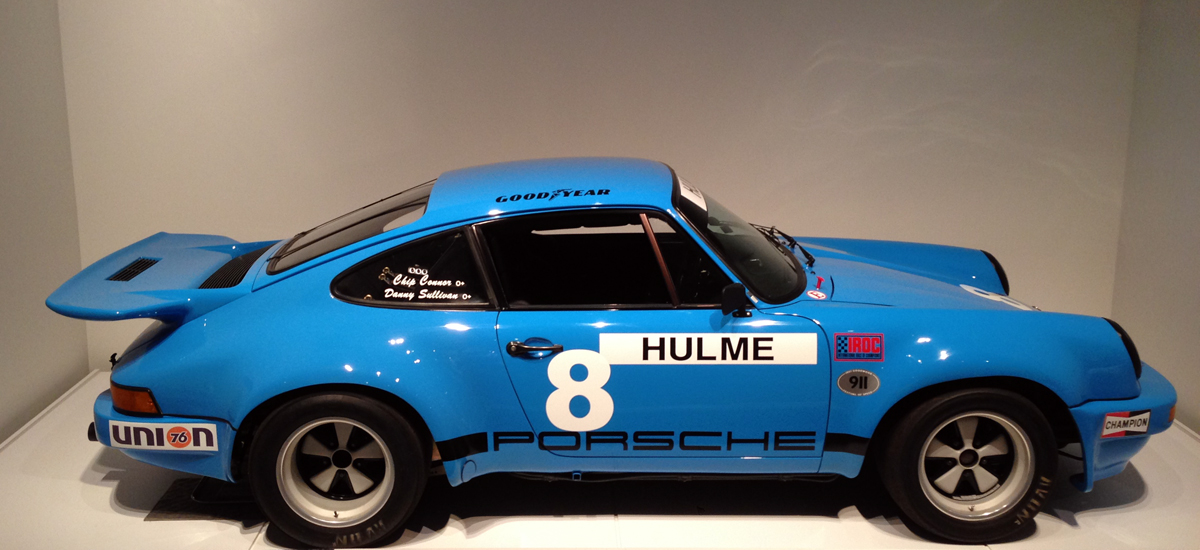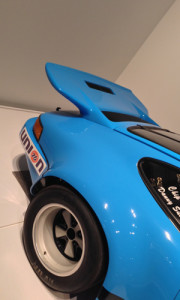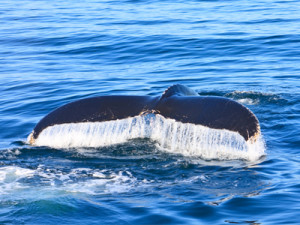
IROC Porsche Type 911 Carrera RSR, 1974
William E. (Chip) Connor Collection
Let’s learn something about the intersection of nature and design.
Let’s do something new for this entry. Let’s focus on design instead of art and discuss the relationship between nature and design. First, what is this? It is a car—a race car to be exact. It is called an IROC Porsche Type 911 Carrera RSR. For those of you who love racing competitions, you probably know what IROC stands for. IROC stands for International Race of Champions. In the day, invited IROC drivers who were at the top of their game raced virtually identical car models on oval race tracks in order to determine who was the best race car driver. IROC was similar to an all-star game, in which the best players or “stars” of a sports league are showcased in a game. For the inaugural series in 1974, fifteen Porsche Type 911 Carrera RSR cars were chosen, twelve of them for the competition and three spares. The cars came in a rainbow of colors so TV viewers could easily follow the cars as they raced around the track. Our Porsche Type 911 Carrera RSR model here is in a lovely hue called Mexico Blue. David Pearson, NASCAR Rookie of the Year, drove this car in the inaugural series along with Denny Hulme and Roger McCluskey. For those of you who are fans of David Pearson, I’m sure you are familiar with the National Association for Stock Car Auto Racing (NASCAR). Pearson currently holds the second position on NASCAR’s all-time win list with one hundred and five victories.
Designers follow what is called the design cycle. Do you know what the design cycle is? The design cycle is a series of steps designers follow. In formulating a design, a design team will first ask themselves what the problems and constraints are. Next they will imagine or brainstorm ideas and choose one idea. Next they will carefully plan out their design. After this, they will make a diagram or model and gather the necessary materials. Next they will create a model and test it. Lastly, if problems arise in the testing phase, they will start the design cycle over and improve upon their design.
What is most obvious about the body design of the IROC? The IROC has a large rear spoiler. What is this type of spoiler called? It is called a whale tail. Why was such a spoiler necessary? As engines became more and more powerful, designers had to come up with solutions to neutralize problems in instability and handling. Two solutions were wider tires and bigger breaks. The IROC race car has what are called Fuchs wheels, which are wider and allow for greater control and handling at increased speeds. Another solution was to attach a rear spoiler. What is the function of a spoiler? A spoiler provides downforce. What is downforce? Downforce is a downward thrust that allows a car to travel faster around a corner. Essentially, it increases the vertical force on the tires and creates more grip against the surface of the road. It is the same principle that allows an airplane to rise off the ground by creating lift from its wings. Keep in mind that the greater the downforce, the greater the drag. Drag is important to aerodynamics. What is aerodynamics? Aerodynamics is the study of how the shape of an object moves air aside. It is a problem in fluid dynamics. If a vehicle has low drag in that the air flows freely across its body, it will have good aerodynamics and speed. Since in designing a race car a design team seeks to minimize drag—not increase drag, designers of the IROC had to find the optimum balance between downforce and drag, just two problems they had to tackle in the design cycle.
Why do you think people called the large, rear spoiler on the IROC a “whale tail?” What can you tell me about a real whale’s tail? A whale’s tail is made of two flukes, which propel a whale by vertical movement, as opposed to the horizontal movement of a fish tail. Since the flared shape and force of this type of spoiler were similar to that of a whale’s tail, it was only fitting that it be named as such. After all, a spoiler increases vertical force to reduce rear-end lift, while a whale’s tail propels the animal with a vertical force through the water. You may be interested to learn that today engineers are studying the shape and function of a whale’s fins and tail to come up with a more efficient way to generate wind power. When designers deliberately use nature as a source of inspiration in the design cycle, they are practicing what is called biomimicry. Do you know what “biomimicry” means? Let’s break the word down into parts. “Bio” means life and “mimicry” means imitate. Biomimicry means to imitate or copy nature. Designers practice biomimicry when they closely observe how nature works and copy nature to solve problems that arise in the design cycle.
Can you think of any examples of biomimicry? One example is a very fast train in Japan called the Shinkansen, referred to as the bullet train. At first, engineers followed the design cycle and came up with a design for a train that could travel at 200 miles per hour. However, when they tested their model, they discovered the train created a piercing sonic boom when exiting a narrow tunnel. The main part of the problem was the blunt, bullet-shaped nose that pushed air in front rather than slicing through. To solve the problem, the engineers looked to nature for inspiration. They took their cue from the beak of the kingfisher. What is the function of a bird’s beak exactly? Birds use their beaks to eat and groom, manipulate objects, kill prey, fight, and feed their young. What is so special about the kingfisher’s beak? A kingfisher is able to dive into water without barely making a splash. Essentially, a kingfisher wedges itself into a body of water with little displacement of water, because its streamlined beak gradually increases in diameter from tip to head. Engineers realized that a similar design for the nose of their train would push air aside the way water flows past the kingfisher’s beak. By going through the design cycle more than once, the engineers were able to redesign the nose of the bullet train to imitate the kingfisher’s beak. By practicing biomimicry, the engineers were able to solve several problems and come up with a design for a much quieter and faster train that also used less electricity.
Another example of biomimicry is Velcro. What is Velcro? Do you know? Velcro is a special material with a hook and loop design. An electrical engineer came up with the design after returning home from a hunting trip with his dog in the Alps. He removed the many little prickly seeds called cockleburs of burdock that stuck to his clothes and his dog’s fur and examined them under a microscope. He was struck by the natural design. The cockleburs were composed of hundreds of tiny hooks that easily caught on anything with a loop such as clothing and animal fur. So he set out to imitate nature and invented Velcro. Essentially, Velcro consists of tiny hooks on one side and even smaller and “hairier” loops on the other. When the two sides are pressed together, the hooks catch in the loops and the two pieces fasten together. To separate the two sides, all one has to do is pull the two sides apart. Perhaps you have seen sneakers or shoes that are fastened by Velcro instead of shoe laces? If you have, I am sure you remember the ripping sound the Velcro strips made when being pulled apart.
The designs of the Shinkansen and Velcro are only two examples of biomimicry. For those of you who love design, why don’t you search for more examples of biomimicry on your own? For those of you who are more interested in art than design, be patient. We will return to the topic of art in our next entry. However, keep in mind that art shares many characteristics with design, which is especially true in the case of architecture and sculpture. For example, artists have to consider shape, materials, and implied movement when designing sculpture. Like a Porsche designer, the Italian Renaissance artist Michelangelo had to take into consideration dimensions, proportions, dynamics, materials, means of construction, surface treatment, display space, and audience when designing his masterpiece David. We will study sculpture in a future entry. Until then, remember the design cycle. It is important. Also remember the design of the IROC. To many observers, it gives the impression of movement so smooth, it appears to glide through space!

